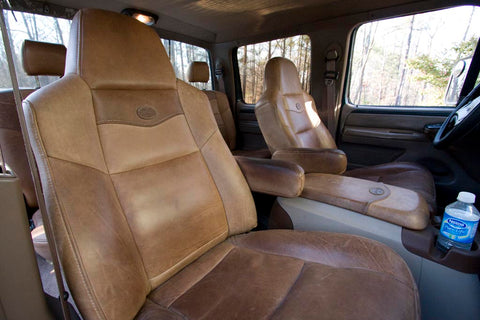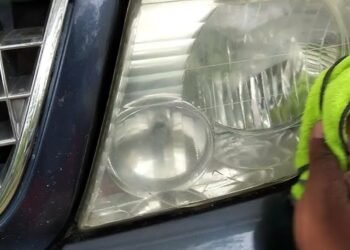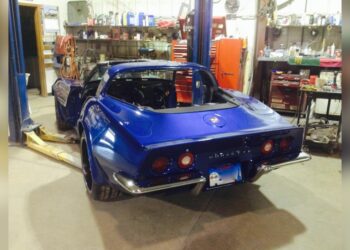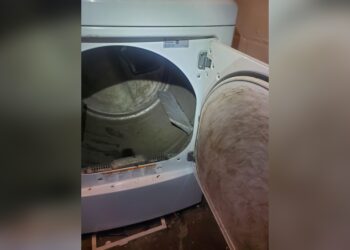Are you thinking about upgrading your F250’s interior and wondering if F150 seats could be a perfect fit? Swapping seats between these two popular Ford trucks might seem simple at first, but there’s more to it than just sliding them in.
You need to consider factors like model year compatibility, wiring for seat features, and mounting brackets. Getting the right fit can transform your driving comfort and style, but a wrong swap could leave you with a frustrating mess. You’ll discover everything you need to know to make an informed decision about whether F150 seats will fit in your F250 — and how to pull off the swap smoothly if they do.
Keep reading to avoid costly mistakes and upgrade your truck’s interior like a pro.
Credit: www.powerstroke.org
F150 And F250 Cab Similarities
The Ford F150 and F250 trucks share many cab features. These similarities impact seat compatibility between the two models. Understanding their cab structure and interior size helps clarify if F150 seats fit in an F250.
Cab Structure And Design
The cab structure of the F150 and F250 is very similar. Both trucks use the same basic frame from the A-pillars to the back of the cab. This means the general shape and mounting points align well. The doors, windows, and roof lines match closely. This shared design allows parts like seats to fit with fewer modifications. The strong frame supports heavy-duty use in both models. Despite different purposes, their cab shells remain nearly identical.
Interior Size And Treatments
The interior size of the F150 and F250 cabs is almost the same. Both offer similar legroom, headroom, and width. This means seats from one model physically fit inside the other. Interior finishes and treatments may differ between models. The F250 may have more rugged materials or added features for work use. The F150 often focuses on comfort and style. Even with varied trims, the basic seat mounting points remain consistent. This supports seat swapping across these trucks.
Key Differences Between F150 And F250
The Ford F150 and F250 serve different needs despite sharing some design traits. Understanding their key differences helps decide if F150 seats fit into an F250. This section highlights the main contrasts between these trucks.
Intended Use And Performance
The F150 is a light-duty truck made for daily driving and moderate tasks. It suits personal use and small hauls. The F250 is a heavy-duty truck built for tough jobs like towing large trailers and carrying heavy loads. It has stronger engines and better towing capacity. The difference in purpose affects their build and features.
Dimensions And Ride Quality
The F150 is smaller and lighter, offering a smoother ride for city and highway driving. It has a softer suspension for comfort. The F250 is larger with a tougher frame and heavy-duty suspension. This makes it better for rough terrain and heavy loads but less nimble in tight spaces. These size and ride differences influence interior space and seating.
Price And Features
The F150 generally costs less with more focus on comfort and technology for everyday use. It includes features aimed at convenience and style. The F250 has a higher price due to its heavy-duty design and stronger components. It often offers fewer luxury options but adds durability and power-related features. This affects seat design and compatibility between models.
Factors Affecting Seat Compatibility
Seat compatibility between an F150 and an F250 depends on multiple factors. These elements influence whether seats can be swapped easily or require modifications. Understanding these factors helps avoid costly mistakes and ensures a proper fit. The main aspects include model year, electrical systems, seat brackets, and seat dimensions.
Model Year And Truck Generation
Each Ford truck generation has unique design changes. The frame and cab structure may look similar but can differ internally. Older F150 seats might not fit newer F250 models due to these updates. Matching the model year and truck generation increases the chance of seat compatibility.
Electrical Systems And Wiring
Modern seats often have electrical components like airbags, heating, or power adjustments. Wiring harnesses differ between F150 and F250 trucks. Incorrect wiring connections can cause malfunctions or safety issues. Verifying electrical compatibility or using adapters is essential for proper seat function.
Seat Bracketry And Mounting
Seat brackets determine how seats attach to the truck floor. F150 and F250 trucks have different mounting points and bracket designs. Using non-compatible brackets may require custom fabrication. Proper mounting ensures safety and prevents seat movement during driving.
Seat Size And Legroom
The physical size of the seats affects fit and comfort. F250 seats tend to be larger to match the truck’s heavy-duty nature. Differences in seat width and legroom may cause fitting issues inside the cab. Checking seat dimensions before swapping helps maintain cabin space and comfort.
Credit: www.ford-trucks.com
Seat Swap Preparation
Preparing to swap F150 seats into an F250 requires careful steps. Proper preparation ensures a smooth and safe installation. It helps avoid damage and extra costs. Follow these key steps before starting your seat swap project.
Researching Compatibility
Start by confirming if the seats fit your truck’s model year. F150 and F250 seats come from different truck classes. Their frames and designs may differ. Check online forums and manufacturer guides for fitment info. Compare seat dimensions and mounting points. Knowing compatibility saves time and effort.
Checking Electrical Connectors
Seats with power features use electrical connectors. Heating, cooling, and power adjustments need wiring connections. Inspect both seat and truck connectors closely. Look for matching plugs and wiring harnesses. Mismatched connectors can cause electrical issues or malfunction. Prepare adapter kits if needed for proper connections.
Inspecting Seat Brackets
Seat brackets secure seats to the truck floor. Brackets may vary between F150 and F250 models. Remove the seats and examine their brackets carefully. Measure bolt patterns and bracket shapes. Ensure brackets align with your truck’s mounting points. Modifying or replacing brackets might be necessary for a secure fit.
Performing The Seat Swap
Performing the seat swap between an F150 and an F250 involves more than just moving the seat. You must address mounting, wiring, and safety concerns. Careful steps ensure the new seat fits well and works correctly. This section breaks down key tasks for a successful swap.
Reusing Or Modifying Brackets
Brackets hold the seat firmly in place. F150 seats sometimes use different brackets than F250 seats. Check if the existing F250 brackets match the F150 seat mounts. If they do not align, you may need to modify or replace brackets. Use strong, secure brackets to avoid any movement during driving. Proper bracket fitment ensures the seat stays stable and safe.
Handling Wiring Adjustments
Seats often have wiring for features like airbags, seat heaters, or power controls. F150 and F250 wiring connectors may differ. Identify the wiring plugs on the F150 seat and compare them to the F250 sockets. You might need adapters or to splice wires carefully. Always disconnect the battery before working on electrical parts. Check all connections twice to avoid faults or warning lights.
Ensuring Proper Fit And Safety
After mounting and wiring, test the seat’s fit carefully. The seat should sit flush with the floor and align with the seatbelt anchor points. Make sure the seat moves smoothly on its rails. Confirm all electrical features operate correctly. Verify airbags and safety sensors work as intended. A well-installed seat provides comfort and crucial protection in a crash.

Credit: www.oemcarandtruckseats.com
Common Challenges And Solutions
Swapping F150 seats into an F250 can be appealing for comfort or style upgrades. The process is not always straightforward. Several challenges arise due to differences in wiring, mounting, and seat design. Understanding these issues helps avoid costly mistakes and ensures a smooth installation. Solutions exist for most common problems, making the swap doable with some effort.
Dealing With Wiring Harness Differences
F150 and F250 seats may use different wiring connectors. This affects power seats, heaters, and airbags. Direct plug-and-play is rare. Adapters or custom wiring often become necessary. Identify the wiring harness type on both seats before starting. Use wiring diagrams to match wires correctly. This prevents electrical faults or safety system errors. Some users splice wires carefully and secure connections with waterproof connectors.
Adjusting Mounting Points
Mounting points on the F150 seats rarely align perfectly with F250 floor brackets. The frame size and seat base design differ slightly. Modifying mounting holes or using spacer brackets can help. Measure twice and test fit before drilling. Always use high-strength bolts to secure seats. Proper alignment is crucial for seat stability and safety. Consider the seat recline and adjustability range after mounting.
Custom Fabrication Tips
Custom fabrication may be needed for a perfect fit. Fabricate new mounting brackets from steel plates if needed. Ensure brackets support the seat’s weight and movement. Weld or bolt parts securely for durability. Use rust-resistant paint on metal parts after fabrication. Padding or trim modifications might be required to match the F250 interior. Take your time with measurements and test the fit repeatedly during fabrication.
Upgrading To Newer Super Duty Seats
Upgrading to newer Super Duty seats can enhance comfort and style inside your F250. Modern seats offer better support and updated features that improve your driving experience. Swapping seats is popular among Ford truck owners who want a fresh, modern look without buying a new truck. Before upgrading, check compatibility and differences in seat styles to ensure a smooth fit.
Compatibility With Older F-series Trucks
Seats from newer Super Duty trucks may fit older F-Series models, but some adjustments are needed. The cab structure in many Ford trucks remains similar across years, aiding compatibility. Mounting points often align, making installation easier. Electrical connections for power seats or heaters might differ. Confirm wiring and connectors before swapping seats. Some older trucks lack wiring for heated or power-adjustable seats. Basic manual seats usually swap without extra wiring.
Differences In Seat Styles And Features
Newer Super Duty seats come with various styles and features. Options include leather upholstery, power adjustments, and heating. Some seats have memory settings or lumbar support. The F150 seats often focus on comfort and tech features for lighter duty use. F250 seats tend to be more rugged and built for heavy use. Seat dimensions may vary slightly, so check measurements before installation. Choose seats that match your comfort needs and truck use.
Frequently Asked Questions
Are The F-150 And F-250 The Same Cab Size?
The F-150 and F-250 share similar cab sizes and structures from the A-pillars to the rear. Interior space is nearly identical, but features and treatments differ. Seat brackets and electrical systems may vary, requiring adjustments for seat swaps between these models.
Do The F-150 And F-250 Have The Same Frame?
The F-150 and F-250 do not share the same frame. The F-250 has a heavier, sturdier frame designed for heavy-duty use. The F-150 frame is lighter and built for everyday driving and moderate tasks. Frame differences affect towing, payload, and overall durability.
Why Avoid Used Ford F-250 Super Duty?
Avoid used Ford F-250 Super Duty due to potential costly repairs, high mileage wear, and complex electrical or seat compatibility issues.
What Is The Main Difference Between An F-150 And F-250?
The main difference is the F-150 is a light-duty truck for everyday use. The F-250 is heavy-duty, built for towing and hauling heavier loads.
Conclusion
F150 seats can fit in an F250, but some adjustments are needed. Both trucks share similar cab sizes, making basic fitment possible. Wiring for seat features like heating or power may require changes. Seat brackets might not align perfectly and could need modification.
Always check the model years to ensure compatibility. With careful work, you can install F150 seats in your F250. This swap can improve comfort but requires some effort. Consider these points before starting the project to avoid surprises.

















